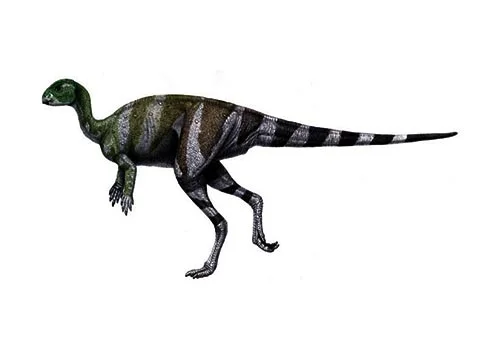Othnielia (Othniel’s Dinosaur)

oth-ni-ee-lee-a
Othniel Charles Marsh - 1877
Carnivore
Estimated 1.5 meters long
Euornithopod
O. rex (type)
USA – Wyoming
Late Jurassic, 155-150 million years ago
Othnielia Facts
Othnielia is a genus of small, herbivorous dinosaur that lived during the Late Jurassic period, around 155-150 million years ago. It was first discovered in Wyoming, USA, and was named after Othniel Charles Marsh, a prominent paleontologist of the late 19th century.
Othnielia was a member of the family Hypsilophodontidae, which were small, bipedal herbivores that lived during the Jurassic and Cretaceous periods. It was about 1.5 meters (5 feet) in length and weighed around 20 kilograms (44 pounds).
Othnielia had a slender build, long legs, and a long tail. It had a small, narrow skull with large eyes and a pointed snout. Its teeth were leaf-shaped and adapted for cutting and grinding plant material.
Based on its anatomy, Othnielia is thought to have been a fast runner and a good jumper. It likely used its strong legs and tail to escape from predators or to reach high vegetation. It may have lived in small herds, with individuals cooperating to avoid predators and find food.
Othnielia is an important dinosaur for scientists to study because it provides valuable information about the diversity and ecology of small herbivorous dinosaurs. Its slender build and long legs are characteristic of the hypsilophodontids, a family of small, bipedal herbivores that were widely distributed throughout the world during the Jurassic and Cretaceous periods. The discovery of Othnielia and other hypsilophodontids has helped scientists to understand how these dinosaurs adapted to different environments and lifestyles, and how they coexisted with other dinosaurs and animals during the Age of Dinosaurs.
In conclusion, Othnielia was a small, herbivorous dinosaur that lived during the Late Jurassic period. Its slender build, long legs, and leaf-shaped teeth are characteristic of the hypsilophodontids, a family of small, bipedal herbivores that were widely distributed throughout the world during the Jurassic and Cretaceous periods. Its anatomy suggests that it was a fast runner and a good jumper, and may have lived in small herds. The discovery of Othnielia and other hypsilophodontids has helped scientists to understand the diversity and ecology of small herbivorous dinosaurs, and sheds light on the complex web of life that existed during the Age of Dinosaurs.



